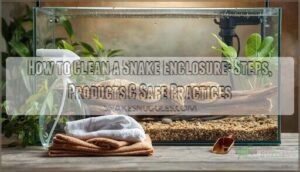This site is supported by our readers. We may earn a commission, at no cost to you, if you purchase through links.
A single speck of dirt clinging to your glove can carry far more risk than most people suspect. Snake fungal infections don’t announce themselves with drama—they settle in quietly, exploiting a moment’s lapse in caution or a skipped cleaning step.
Long before scales show signs of trouble, the fungus has already found a foothold, feeding on the smallest weaknesses in routine. Snake keepers who understand this invisible threat know prevention means vigilance, not luck.
With the right handling, hygiene, and smart attention to early warning signs, you’ll stack the odds in your favor and help keep your snakes healthy for the long haul.
Table Of Contents
Key Takeaways
- Maintaining strict hygiene—such as cleaning gloves, tools, and enclosures—prevents fungal spores from spreading and infecting snakes.
- Regular health checks and early detection of subtle symptoms, like swelling or skin lesions, greatly improve your chances of stopping a snake fungal infection before it worsens.
- Limiting direct contact, using proper protective barriers, and enforcing strict quarantine for new or sick snakes are essential to protect both individual animals and entire collections.
- Community education, safe handling habits, and habitat management reduce risk not just for your own snakes, but also for broader reptile populations.
Causes and Spread of Snake Fungal Infections
Understanding how snake fungal infections take hold is your best tool for preventing them. These infections don’t just appear out of nowhere—they spread in specific ways you can control.
Here’s what to watch for and why certain options can make all the difference.
How Ophidiomyces Ophiodiicola Infects Snakes
When a snake’s outer skin barrier gets breached, even a tiny scratch opens the door for Ophidiomyces ophiodiicola. This fungus triggers immune cell responses that create swelling and crusting at the site. Over time, lesion development can reach deeper tissue layers.
One known cause is Snake Fungal Disease. How severe the infection gets depends on both environmental susceptibility and the snake’s natural immune defenses.
Environmental and Indirect Transmission Pathways
Open ground, especially soil within hibernacula, acts as a reservoir for fungal spores. These spores persist, clinging to surfaces and gear. Every step through contaminated soil risks accidental spread—on boots, tongs, or gloves.
Human-mediated spread and lax environmental hygiene both encourage environmental contamination. Staying vigilant about cleaning, and avoiding indirect contact, makes all the difference in reducing fungal spore dispersal and soil contamination.
The fungus, Ophidiomyces ophidiicola, has been detected in topsoil samples.
Risk Factors for Infection in Captive and Wild Snakes
From contaminated boots to the microclimate inside an enclosure, risks for snake fungal infection are often overlooked. You’ll want to watch for:
- Hibernation risks—snakes packed in cold dens face higher infection odds.
- Captive conditions—humidity, cleaning lapses, and poor quarantine.
- Species susceptibility—rattlesnakes and rat snakes struggle most.
- Soil exposure and climate impact—damp habitats invite fungal persistence.
Safe Snake Handling and Personal Hygiene
Regarding keeping snakes healthy, how you handle them matters just as much as where they live. Staying clean and using the right tools goes a long way in stopping the spread of disease.
Here’s what you need to know before you even open the enclosure.
Proper Use of Gloves, Hooks, and Tongs
Bite prevention starts with the right glove material—choose thick, puncture-resistant types. Use long, sturdy snake hooks with a reliable design to keep a safe handling distance. Tongs fitted with soft padding help prevent injury.
Clean handling gear after every use, and practice consistent snake handling techniques. These safe snake handling habits limit fungal transmission and protect both you and the animal.
Minimizing Direct Contact and Handling Frequency
Even well-meaning moments with your snake can open doors to infection if you’re not careful. Reducing handling frequency and physical contact is one of the best ways to stop contact transmission routes in their tracks. Combine these strategies with protective barrier use and strong handling timing for real results:
- Limit unnecessary handling
- Use gloves and snake hooks
- Avoid direct contact
- Handle during low-risk periods
- Train on safe snake handling techniques
Cleaning and Disinfecting Equipment After Use
If you want your cleaning routines to work, you can’t cut corners—organic debris removal comes first, every time. After that, use dedicated cleaning tools and pay attention to disinfectant exposure times, letting chemicals sit long enough to destroy spores. Safe chemical rinsing and thorough drying matter, too.
Remember: regular footbath maintenance and choosing the right sanitizer keep your hygiene standards high.
Maintaining Clean and Healthy Snake Environments
Keeping your snake’s habitat clean and balanced is key to avoiding fungal infections. A few small changes in how you care for their space can make a big difference in their health.
Here’s what to pay attention to as you set up and maintain their enclosure.
Regular Enclosure Cleaning and Disinfection
Think your snake’s home is clean enough? Regular snake enclosure cleaning is your strongest defense against infection. Daily spot cleaning and weekly deep cleaning cut down pathogens, while proven disinfectant protocols—like diluted bleach or F10SC—lower fungal spores.
Stick to documented cleaning routines and hygiene control. Tracking cleaning frequency and using separate tools helps guarantee safe, healthy enclosure conditions every time.
Controlling Humidity and Temperature Levels
Humidity spikes can creep in quietly, fueling snake fungal outbreaks before you notice. Keep your humidity monitoring sharp—aim for low humidity and stable temperature gradients while using well-maintained ventilation systems to keep air moving.
Check for leaks often, make smart seasonal adjustments, and focus on thermal regulation. Maintaining ideal temperature is your frontline defense against persistent moisture and lurking pathogens.
Reducing Organic Matter and Fungal Spore Spread
Picture fungal spores like splinters hiding in messy corners—every bit of organic matter left unchecked becomes fuel for disease. Stay two steps ahead with strict hygiene practices: replace soiled substrate, target cleaning around waste sites, and keep logs.
Effective organic matter management and regular cleaning reduce spore shedding, and also tap into soil microbial suppression for strong environmental control.
Quarantine Protocols for New or Sick Snakes
Quarantine acts as your biosecurity firewall—isolating new or sick snakes for a minimum of eight weeks keeps hidden infections from gaining ground. Sticking to strict quarantine duration, daily diagnostic monitoring, and rigorous disinfection protocols creates a shield against disease spread.
Regular surveillance tracing and careful release procedures, including health checks and repeated pathogen testing, turn strong hygiene practices into population-wide protection.
Monitoring and Early Detection of Infection
Regular checks are the best way to spot trouble early and keep your snakes healthy. By paying close attention, you can catch changes before they become serious.
Here’s what to watch for as you monitor your snakes and their care.
Recognizing Early Symptoms of Snake Fungal Disease
Early symptoms of snake fungal infection unfold right before your eyes if you know what to look for. Watch for facial swelling, eye abnormalities like cloudiness, and crusted or ulcerated scales.
Behavior changes—like extra basking or skipped meals—often show up before you expect. Even small molting changes and unexplained skin lesions are warning flags that shouldn’t be overlooked.
Routine Health Checks and Population Monitoring
Spotting early symptoms of snake fungal infection is just the start. Annual wellness exams catch what eyes miss, and health monitoring outcomes shape your response.
Diagnostic techniques like DNA testing confirm what’s really under the scales.
Consistent population surveillance and habitat monitoring let you keep tabs on snake populations—so you respond quickly, thanks to standardized reporting and sharp symptom recognition.
Reporting Suspected Cases to Authorities
Whenever you notice early symptoms of snake fungal infection, take quick, thoughtful action. Use available reporting methods for your location—photos, forms, or wildlife hotlines—keeping data privacy in mind.
Public participation helps agencies coordinate responses and track outbreaks. Extensive reporting protocols, international reporting, and close agency coordination all work together, turning local vigilance into powerful, worldwide disease monitoring and education on SFD symptoms.
Community Education and Preventive Measures
Getting your community involved is one of the most effective tools you have against the spread of snake fungal disease. Teaching everyone safe habits and why they matter helps keep both people and snakes safe.
Here’s what to focus on as you build those preventive routines together.
Teaching Safe Snake Handling and Disease Prevention
Ever notice how the smallest habits can make or break biosecurity? Training programs teach you how safe handling and Glove Effectiveness lower your risk. Disease Awareness drills, public outreach, and Adherence Monitoring aren’t just buzzwords—they save snakes and handlers alike. If you care about preventing disease spread, community education is your strongest line of defense.
Community education on safe handling habits is the frontline defense that protects both snakes and handlers from disease
- Build confidence, don’t just follow rules
- Gloves aren’t optional—think protection first
- Good habits outlast panic
- Training changes your instincts, not just your skills
Encouraging Habitat Awareness and Responsible Interaction
Building Habitat Preservation into your routine means every outing becomes a lesson in Responsible Observation. Choose Safe Basking spots for monitoring—never disturb shelter or eggs.
Community Engagement works best when you model sound hygiene and habitat management, reinforcing public safety. Simple acts, like minimizing habitat disturbance and sharing facts, support Ecosystem Health while lowering the risk of disease spread through consistent, practical community education.
Supporting Research and Public Awareness Campaigns
Through dedicated funding allocation, research collaboration, and strong public engagement, you strengthen the fight against Snake Fungal Disease. Campaign effectiveness improves when educational resources reach more people, and partner agencies unite to educate the public on SFD symptoms and safety.
Active community education and awareness make certain that every contribution—big or small—moves research and prevention efforts forward.
Frequently Asked Questions (FAQs)
Can snake fungal infections affect other reptiles or pets?
Snake fungal infections, like those caused by Ophidiomyces ophiodiicola, can cross-infect other reptiles—especially lizards—through environmental persistence and asymptomatic carriers.
Thankfully, current data show negligible zoonotic potential and little threat to mammals or birds with solid biosecurity measures.
Are there natural remedies for treating snake fungal infections?
Picture a reptile’s scales glistening under careful hands—natural remedies like Tea tree oil, Coconut oil, Apple cider vinegar, Garlic application, and Lemongrass show some antifungal treatment promise, but antifungal medications remain the preferred disease treatment options for fungal infection.
How long does the fungus survive in the environment?
Ophidiomyces survives in contaminated soil and on shed skin for months. Soil persistence peaks in warm seasons, with environmental detection rising as snakes shed fungal spores.
No precise viability limits exist, but organic matter fuels longer-lasting environmental factors.
What should I do if my snake refuses antifungal treatment?
If your snake refuses antifungal treatment, explore Nebulization Therapy or Topical Treatments, provide Nutritional Support, and prioritize Stress Reduction.
Veterinary Consultation remains essential—specialists offer specific snake care tips, guidance on maintaining hygiene, and support for ongoing snake health.
Conclusion
Think of your snake’s health like guarding a rare coin: a single fingerprint, left unnoticed, risks everything. Applying snake fungal infection prevention tips becomes more than routine—it’s your best defense against an enemy you may never see coming.
Each habit, from washing your hands to watching for subtle skin changes, acts like a lock on the vault. When vigilance replaces guesswork, you tip the scales. Protection isn’t luck; it’s a practice you choose every day.














